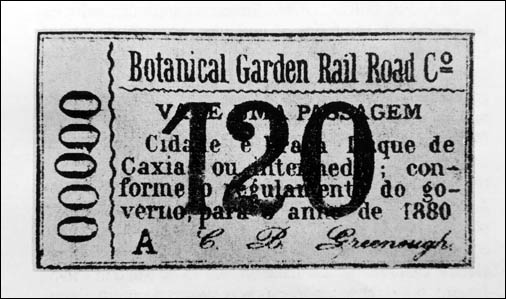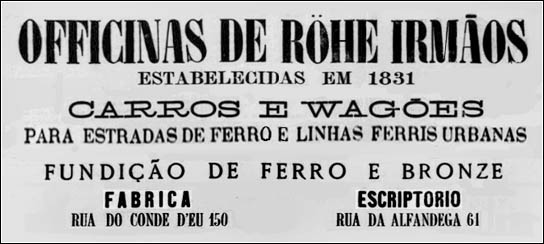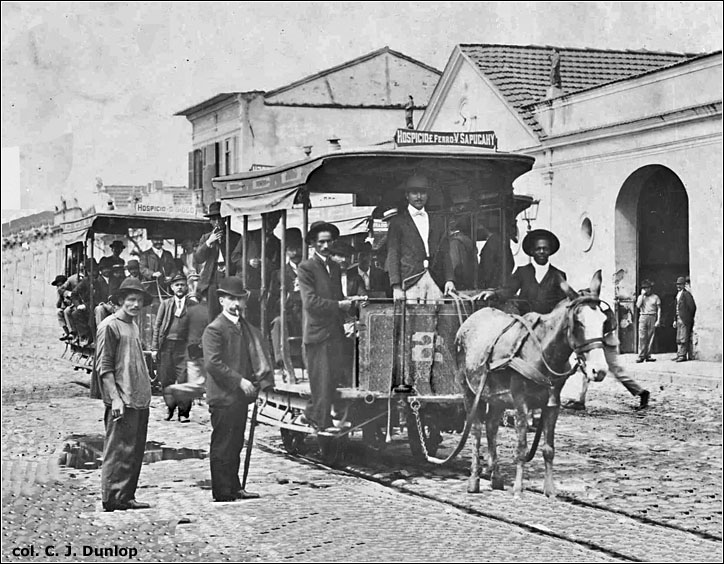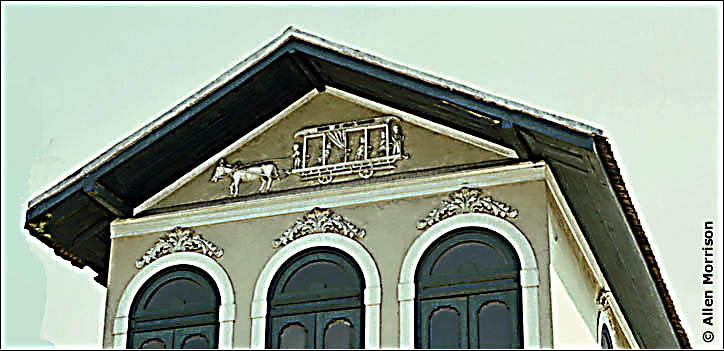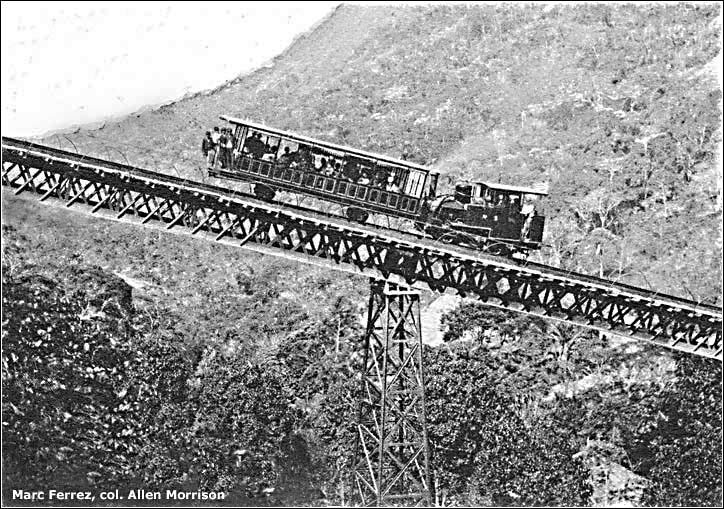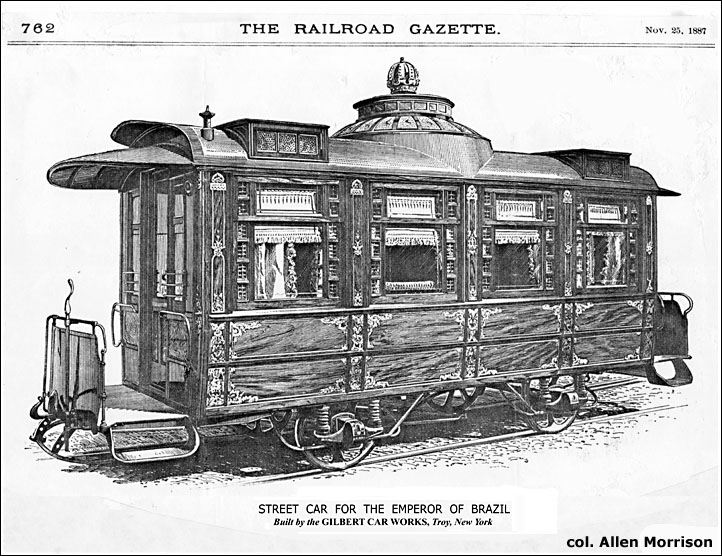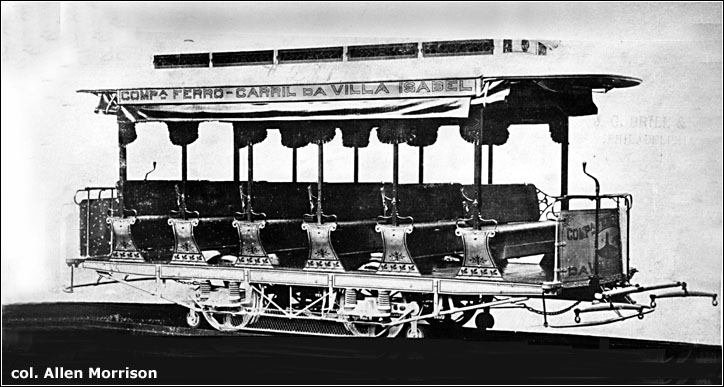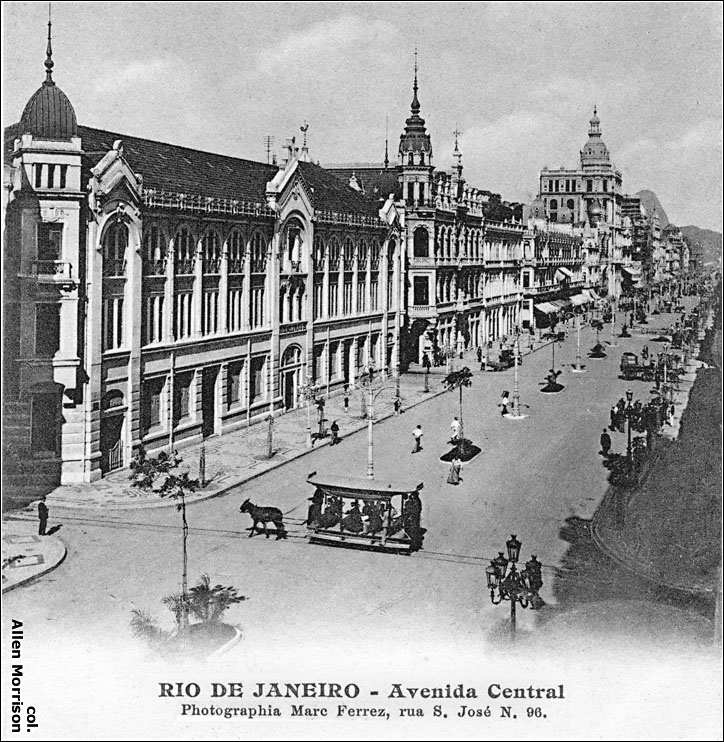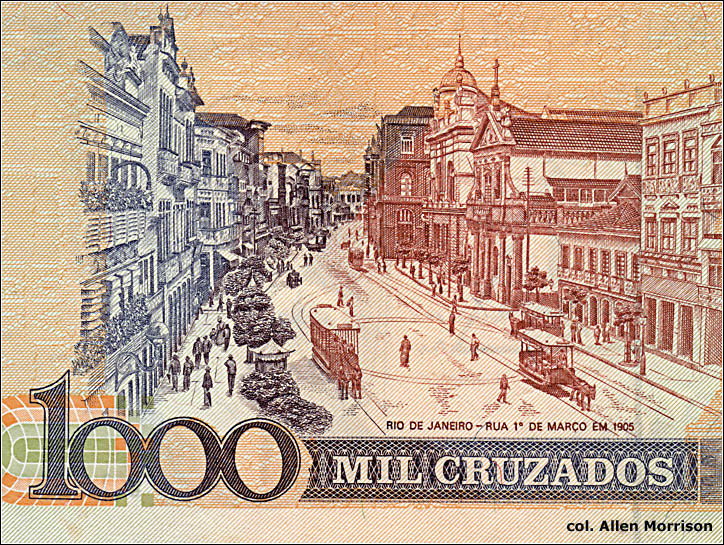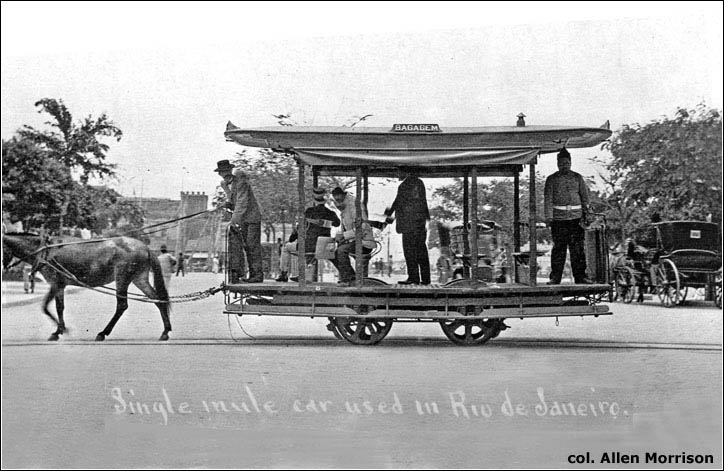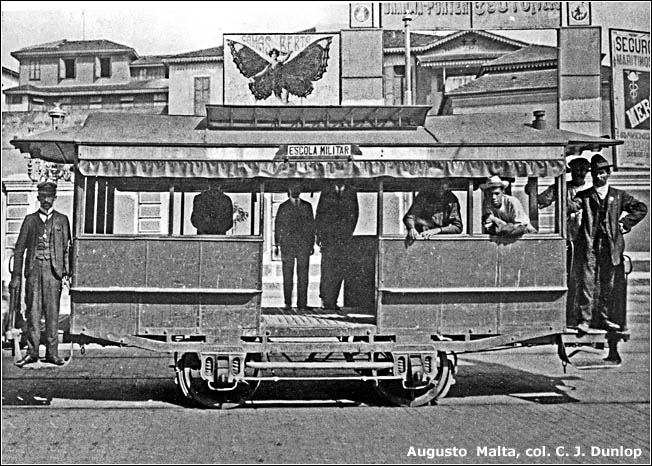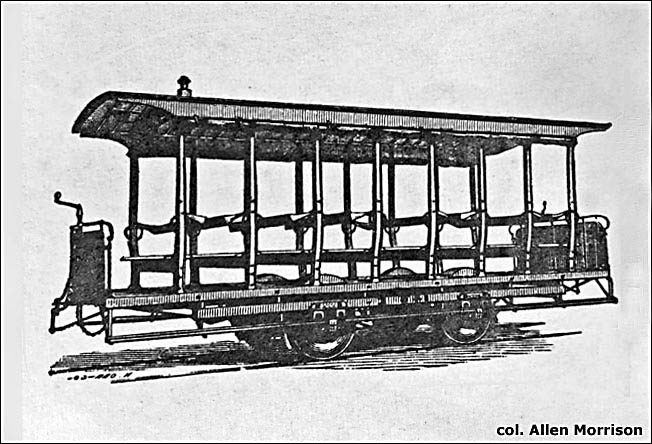RIO DE JANEIRO
Tramway History in 75 Photographs
from the collection of
Allen Morrison
| This is an illustrated survey of tramway development in Rio de
Janeiro, Brazil, showing images that did not appear in my book The Tramways of Brazil or on the pages indexed at Electric Transport in Latin America. Part 1 (of 3): 1859-1890 Rio de Janeiro was the test ground for tramways in Brazil: it had its first animal-powered line in 1859, first steam-powered line in 1862, first electric line in 1892, etc. It ultimately had more tramway companies, trams, types of trams, tram gauges and kilometers of tram track than any other city. Early development was international. Thomas Cochrane was a homeopathic physician from Scotland (and cousin of the naval hero of the same name). Irineu Evangelista de Souza, the "Baron of Mauá", was an entrepreneur, industrialist, banker, politician and the richest man in Brazil. Charles Greenough was the former chief engineer and manager of a streetcar line in the United States. The Baron of Mauá built and inaugurated the first section of Brazil's first intercity railroad in 1854. Thomas Cochrane founded the Companhia de Carris de Ferro da Cidade á Boa-Vista na Tijuca in 1856 and built Brazil's first urban railway: a 7 km line that ran from Praça Tiradentes west along Ruas da Constituição, Visconde de Itaúna, Machado Coelho, Haddock Lobo and Conde de Bonfim to the suburb of Tijuca [see map]. Track gauge was 1676 mm/66 in, the same that Mauá used on his railroad. Here is part of Cochrane's stock certificate [col. C. J. Dunlop]:  The
vehicle shown on the certificate was not a Tijuca tram. It's a drawing of an
English railway coach of the 1830s that was used to decorate
certificates. The origin and appearance of Tijuca's first trams is
uncertain for most records are lost. But after extensive research English tram historian J.
H. Price decided that they probably came from Joseph Wright &
Sons in Saltley, a suburb of Birmingham, England [col. Ralph Forty]:
The drawing below, published in a London magazine in 1871, shows two trams on the Tijuca line after it had been acquired in 1870 by the U.S.-owned Rio de Janeiro Street Railway Co. The view is authentic and the drawing professional, but the lettering on the trams is amateurish and was no doubt added later. Was the original engraving made in 1859? Does it show Wright's trams? Note that both have three axles and are running left-handed [D. J. Anderson, Eco Americano, London; col. C. J. Dunlop]:
|

| Whatever
their origin and however they looked, the newspaper Jornal do Commercio [sic] reported that the two Tijuca trams began
testing in 1858 and started carrying passengers
on Sunday 30 January 1859. Finally, Emperor Dom Pedro II christened
Brazil's first street railway, the Estrada de Ferro da Tijuca, as it was renamed, the following 26 March. Two horse trams on a 7 km route did not provide good service and meager revenues did not keep the line in working order. The Baron of Mauá took over the company in 1861 and replaced the mules with steam power in 1862. He purchased four locomotives (order number 420/1349) from Sharp, Stewart & Co. in Manchester, England. These were allegedly the first tramway locomotives in South America [Grace's Guide]:
Manoel Felizardo was the Minister of Agriculture who granted Mauá the permission to operate locomotives on the street. The other three machines were named Ireneo, Evangelista and Ajudante. But all four derailed frequently on the flimsy rails and the line closed on 28 November 1866. Meanwhile, Mauá acquired a franchise for a tram route to the Botanical Garden and formed the Companhia do Caminho de Carris de Ferro do Jardim Botânico in 1862. But the banks were disillusioned by the failure of the Tijuca line and investors scarce. Brazil's tramway development might have remained stymied for many years had it not been for the enthusiasm and adventurous spirit of Charles Greenough, engineer and manager of the Bleecker Street & Fulton Ferry Rail Road in New York. Greenough learned of opportunities in Brazil, traveled to Rio de Janeiro, purchased
Mauá's contract, and founded the Botanical Garden
Rail Road Co. in 1866. The Brazilian government was reluctant to
allow another foreigner
to build another street railway in its capital, but permission was
finally granted and on 9 October 1868, in the midst of Brazil's war with
Paraguay, Emperor Dom Pedro II presided at the inauguration of Rio de
Janeiro's second
street railway: a 3 km line that ran from Rua do Ouvidor south along
Ruas Gonçalves Dias, Guarda Velha (13 de Maio), Ajuda, Passeio, Lapa, Glória and Catete to Largo do Machado [see map]. Track gauge was 1435 mm/56.5 in, which was used by Greenough's tramway in New York, and later became the world standard. |
 The photograph below is one of two preserved at the Museum of the City of New York that show vehicles which Stephenson built for the Botanical Garden Rail Road. The tram is numbered "1", so is presumably the first car that it built for Rio. The photograph is also the oldest confirmed view of a tram built for Brazil. The other photograph in the New York collection shows a parlor car that Dom Pedro commissioned in 1878. That vehicle, unfortunately, went down with the ship that was carrying it to Brazil during a storm near Cape Hatteras. |
 |
|
Subsequently, another American, Albert Hager, founded the Rio de Janeiro Street
Railway in New York and opened Rio's third line, between the city and the palace grounds at Quinta da Boa Vista,
on 25 November 1869. Its track gauge was an odd 1372 mm/54 in, but was later changed to 1435 mm/56.5 in to match the Botanical Garden line. Hager renamed his tramway Companhia de São
Cristóvão in 1870 and reopened Cochrane's line to Tijuca, which had been closed for three years. A Brazilian, João Batista Viana Drummond, inaugurated the fourth system, the Ferro-Carril da Vila Isabel, track gauge 1435 mm/56.5 in, on 29 November 1873 [see map]. Four other street railways began operation in the 1870s: Companhia Locomotora in 1872, Companhia Ferro Carril Fluminense in 1873, Empreza de Carris de Ferro de Santa Theresa in 1875, and Companhia Ferro Carril Carioca e Riachuelo in 1877. All these tramways used the same 820 mm/32.3 in track gauge and were consolidated as Companhia de Carris Urbanos in 1879. (The 1875 Santa Teresa line ran only in the flat downtown area of the city. The 1877 Carioca line built a funicular and a separate, isolated, tram line atop the hill, which evolved into the tramway system that survives today.) Most
of Rio's early tramway companies purchased vehicles from John
Stephenson Co. in New York. But there were exceptions. On 23 July 1874 the Companhia Ferro Carril Fluminense ordered 26
trams – 20 open
and 6 closed! – from a Rio carriage maker named Röhe Irmãos. Röhe's ad, which appeared annually in Brazil's Almanak Laemmert,
showed a Stephenson tram on which Röhe had written its name
(compare original Stephenson photograph above). Whether Röhe copied
Stephenson's design, or just used it for publicity, is
unknown. But the trams seem to have been built – and may have been the first trams built in South America. 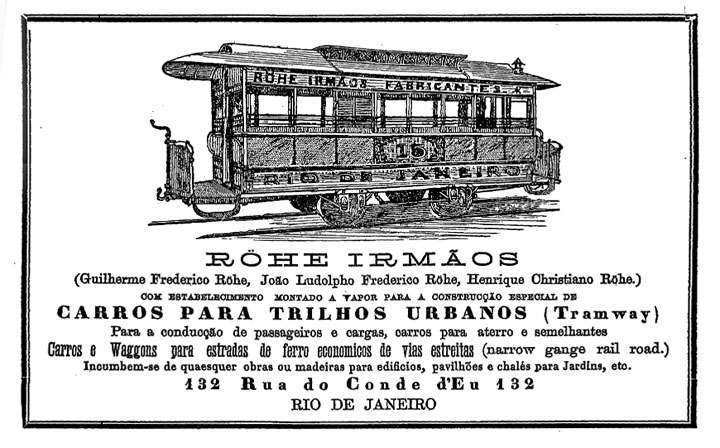
Röhe's carriages, tramcars and other transport equipment were featured prominently at the Exposição da Industria Nacional in 1881. The Jornal do Commercio published this announcement that year:
A review of that exposition noted that Companhia de Carris Urbanos also built trams, which however it judged inferior to those made by Röhe. The article describes this 5-bench model [col. C. J. Dunlop]:
It
was time to change the horses pulling this tram of the C.V.I.
(Companhia Vila Isabel). The steeds on the right seemed very aware of
the camera. Unlike the animals, the coachman is barefoot [col. AM]: 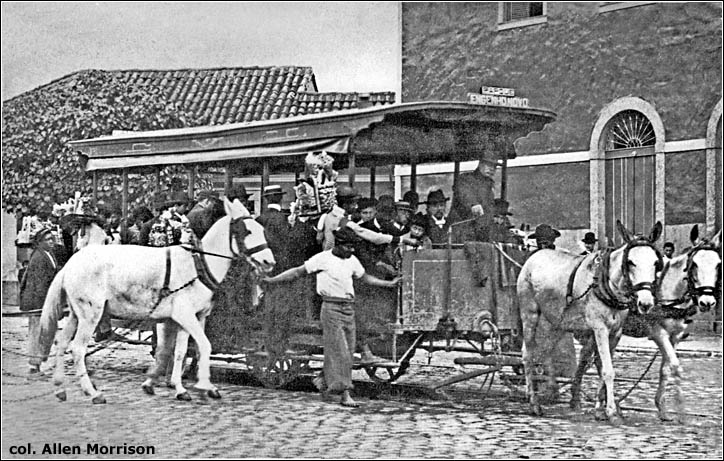
A structure of the "BONDS DA VILLA GUARANY", built in 1883, has been preserved because of this frieze – which has recently been restored. Location, at Rua Pedro Alves 210, is not far from the Praia Formosa terminus of today's new "VLT" (light rail line) [see map] [AM]:
It is not exactly a tram – but it is not really a train, either. The Estrada de Ferro do Corcovado opened the first section of its meter-gauge rack railway, which climbs to a peak at 670 m/2,198 ft, on 9 October 1884 [see map]. The first locomotives came from Maschinenfabrik Esslingen in Germany. It was the first tourist railway in South America and still runs today [AM]:
The
emperor ordered another parlor car in 1887, this time from Gilbert Car
Works in Troy, New York. Its ancestor, Eaton, Gilbert & Co., had
built the
first trams for Mexico City in 1857, Santiago de Chile in 1858 and
Havana, Cuba, in 1859. EG may also have built trams for Rio
de Janeiro, but no photographic or written evidence has been found [col. AM]:
The vehicle above was lengthened and rebuilt as an electric "Luxo Car" in 1912 [col. AM]:
In 1888 the Vila
Isabel company ordered three open trams like this from J. G. Brill Co.
in Philadelphia. The ironwork made the vehicles more durable, but also
heavier and harder for the horses to pull, and Vila Isabel did not
order more [col. AM]:
Most of the
trams that the public rode in the late 19th and early 20th
centuries were small and made of wood. Avenida Central opened in
1905
and was renamed Avenida Rio Branco in 1912, so this postcard was made
between 1905 and 1912. The view is south. The tram is traveling
east: Sugar Loaf
mountain is visible in the distance [see map] [col. AM]:
One of the cruzado
notes used in the 1980s showed a group of such trams on Rua
Primeiro de Março in 1905. This was the commercial center of the
city at that time and the terminus of several horse tram lines [col.
AM]:
This postcard shows a special "bagagem" tram, which carried both baggage and passengers [col. AM]:
Here is another type of baggage car, which Jardim Botânico called a "caradura" (hard face, tough guy). John Stephenson built the first ones in 1884. This photo was taken in 1907 [Augusto Malta, col. C. J. Dunlop]:
The
photograph below shows the open crossbench design that John Stephenson
Co. introduced in 1870 and which became the standard design for open trams throughout Brazil during the 19th century [col. AM]:
This specimen was still running in 1908. The last horse trams in Rio de "Jenerio" were replaced by electric trams in 1910. Why did the sailors want this pose? Were they horse tram enthusiasts? [postcard, col. AM]: |

|
Continue to Part 2 of Rio de Janeiro Tramway History { Part 1 with text in Bashkir, translated by Ayrat Israfilov } |


